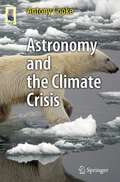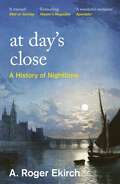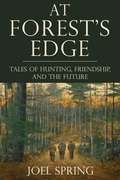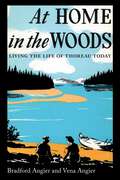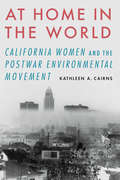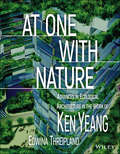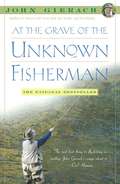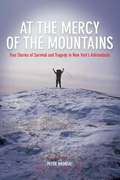- Table View
- List View
Astronomy and the Climate Crisis (Astronomers' Universe)
by Antony CookeClimate change is acknowledged as being one of the most important areas of research today. Increasing global temperatures will impact all of us to a greater or lesser extent. From the point of view of research it is an enormously important and complex subject. However, little attention is paid to its relationship to astronomy, the sun in particular but not exclusively. Though directed at an astronomically inclined readership, and providing some less well-known astronomically related information, studies and concepts, this book will also appeal to a broader public, who need to understand the subject of climate change and learn of all the various theories and possible solutions.
Asymmetric Environmental Governance in Azerbaijan: Oil Pollution and Greenhouse Gas Emissions (Societies and Political Orders in Transition)
by Agshin UmudovThis book examines why authoritarian governments are willing to address environmental problems that have an international impact, such as CO2 emissions, but are reluctant to address problems that have only a domestic impact. In a case study of Azerbaijani oil politics, it demonstrates how the incumbent Azerbaijani regime has taken important measures trying to address CO2 emissions while ignoring the damage caused by oil pollution on the Caspian coast. The book argues that resource-rich authoritarian governments are eager to join international environmental initiatives to improve their image, but they address domestic environmental issues mainly if they threaten their hold on power.This book is an important contribution to scholarship on environmental governance in the post-Soviet space, an area that is poorly researched. Therefore, it is a must-read for researchers and scholars interested in post-Soviet studies, as well as in the nexus between mineral-rich regions and how social policy is created, e.g., environment, education, and healthcare. In addition, this book will be of tremendous importance for policymakers and international organizations as it looks into the motivation of authoritarian states in the post-Soviet space for environmental measures.
Asymmetry in Plants: Biology of Handedness
by Bir Bahadur K. V. Krishnamurthy Monoranjan Ghose S. John AdamsPlants exhibit forms of asymmetry analogous to "handedness" in bilaterally symmetrical animals. This book explores the evolutionary significance and development of asymmetry. Examples of genetic control include the direction of tendril or stem coiling of many climbing plants; the so-called spiral phyllotaxy and floral taxy; and contorted petal arrangement is another kind of left- right symmetry in plants; the direction of contortion is fixed in some but not in other plants. The book will underscore tha all phenomena related to handedness start during embryogenesis itself, with the occurrence of embryo rotation. Key selling features: First consolidated book on Plant Handedness Relates handedness, asymmetry and chirality to the evolution of different organizational levels in plant biology Emphasizes handedness as a vital governing force in plant functional evolution Provides a new perspective, hitherto ignored, into plant developemtn and evolution Describes how an age-old phenomenon can give scope for investigation from a very modern interdisciplinary approach
At Day's Close: A History of Nighttime
by A. Roger EkirchA fascinating and colourful social history of the nighttime in the pre-Industrial era.AT DAY'S CLOSE charts a fresh realm of Western culture, nocturnal life from the late medieval period to the Industrial revolution. The book focuses on the cadences of daily life, investigating nighttime in its own right and resurrecting a rich and complex universe in which persons passed nearly half of their lives - a world, long-lost to historians, of blanket fairs, night freaks, and curtain lectures, of sun-suckers, moon-cursers and night-kings. It is not only the vocabulary that has disappeared, AT DAY'S CLOSE will restitute many facts which have been either lost or forgotten. It is a significant and newsworthy contribution to social history, filled with substantial research, stories and new discoveries.Ekirch uses a wide range of sources to reconstruct how the night was lived in the past : travel accounts, memoirs, letters, poems, plays, court records, coroner's reports, depositions and laws dealing with curfews, crime and lighting. He has analysed working-class autobiographies, proverbs, nursery rhymes, ballads and sermons, and folklore, as well as consulting medical, psychological and anthropological papers.
At Day's Close: A History of Nighttime
by Professor A. Roger EkirchA fascinating and colourful social history of the nighttime.'A wonderful revelation of a vanished age of darkness' SPECTATOR'Fascinating' SUNDAY TIMES'A splendid book ... great entertainment' Sir Patrick Moore'A triumph of social history. Almost every page contains something to surprise the reader ... one of the most enjoyable literary experiences of the year' MAIL ON SUNDAYFrom blanket fairs to night kings, curfews to crime, At Day's Close is an intriguing and captivating investigation into the night. Until now, this rich and complex universe in which we spend nearly half of our lives was a world long-lost to historians. Here, Ekirch explores how the night was lived in the past, through travel accounts, memoirs, letters, folklore, poems, court records and coroner's reports. More than this, it is a passionate argument in the case for less artificial light in an increasingly bright world.
At Every Depth: Our Growing Knowledge of the Changing Oceans
by Tessa Hill Eric SimonsThe world’s oceans are changing at a drastic pace. Beneath the waves and along the coasts, climate change and environmental degradation have spurred the most radical transformations in human history. In response, the people who know the ocean most intimately are taking action for the sake of our shared future. Community scientists track species in California tidepools. Researchers dive into the waters around Sydney to replant kelp forests. Scientists and First Nations communities collaborate to restore clam gardens in the Pacific Northwest.In At Every Depth, the oceanographer Tessa Hill and the science journalist Eric Simons profile these and other efforts to understand and protect marine environments, taking readers to habitats from shallow tidepools to the deep sea. They delve into the many human connections to the ocean—how people live with and make their living from the waters—journeying to places as far-flung as coral reefs, the Great Pacific Garbage Patch, and the Arctic and Antarctic poles. At Every Depth shares the stories of people from all walks of life, including scientists, coastal community members, Indigenous people, shellfish farmers, and fisheries workers. It brings together varied viewpoints, showing how scientists’ research and local and Indigenous knowledge can complement each other to inform a more sustainable future. Poignantly written and grounded in science, this book offers a narrative perspective on the changing oceans, letting us see how our relationships to the oceans are changing too.
At Forest's Edge: Tales of Hunting, Friendship, and The Future
by Joel SpringOutdoor literature lends itself well to reminiscence of the past; days gone by, hunts with old friends, and good dogs long gone. Joel Spring explored the past in depth with The Ghosts of Autumn (Skyhorse Publishing, 2016). In his latest work, At Forest&’s Edge, Spring turns his thoughts and insights to the future and the future of the sport of hunting. In essays span - ning a season afield, At Forest&’s Edge speaks to the upcoming generation of hunters as well as those of us who have a few more miles on our boots. The au - thor weaves humor, sadness, and a sense of hope seamlessly together in another engaging book. Inside you&’ll find deer and ducks, dogs and friends, adventure and reflection. Most importantly, you&’ll find hope for the future. Come take a walk with Joel Spring At Forest&’s Edge .
At Home and Astray
by Philip HowellAlthough the British consider themselves a nation of dog lovers, what we have come to know as the modern dog came into existence only after a profound, and relatively recent, transformation in that country's social attitudes and practices. In At Home and Astray, Philip Howell focuses on Victorian Britain, and especially London, to show how the dog's changing place in society was the subject of intense debate and depended on a fascinating combination of forces even to come about.Despite a relationship with humans going back thousands of years, the dog only became fully domesticated and installed at the heart of the middle-class home in the nineteenth century. Dog breeding and showing proliferated at that time, and dog ownership increased considerably. At the same time, the dog was increasingly policed out of public space, the "stray" becoming the unloved counterpart of the household "pet." Howell shows how this redefinition of the dog's place illuminates our understanding of modernity and the city. He also explores the fascinating process whereby the dog's changing role was proposed, challenged, and confronted--and in the end conditionally accepted. With a supporting cast that includes Charles Dickens, Elizabeth Barrett Browning, Thomas Carlyle, and Charles Darwin, and subjects of inquiry ranging from vivisection and the policing of rabies to pet cemeteries, dog shelters, and the practice of walking the dog, At Home and Astray is a contribution not only to the history of animals but also to our understanding of the Victorian era and its legacies.
At Home in the Woods: Living the Life of Thoreau Today
by Bradford Angier Elvena AngierOne hundred years ago, Henry Thoreau wrote of the charms and joys of simple living in the woods, away from the hectic nuisances of our city civilization. His philosophy has become part of our American heritage, as sound today as the day he first set it down. But his advice on the simple life has seemed too rugged for later generations, brought up in cities, pampered with conveniences and scared of nature.Vena and Brad Angier were fed up with their city bound existence and longtime readers and admirers of Thoreau, they set out to see if his discoveries were valid today. This is the account of two wilderness-loving tenderfeet, who headed for the tall timber on the banks of the Peace River, British Columbia. There near the trading post of Hudson Hope they found their Walden.How they made themselves &‘At Home in the Woods,&’ stocked their cabin, met their interesting wilderness neighbors who helped them get settled and who saw them through their first winter makes honest and exciting reading. The city-bred Angiers found out that Thoreau was right when he wrote: &“What people say you can not do, you try and find you can.&”
At Home in the World: California Women and the Postwar Environmental Movement
by Kathleen A. CairnsFrom the beginning of California&’s statehood, adventurers, scientists, and writers reveled in its majestic landscape. Some were women, though few garnered attention or invitations to join the Sierra Club, the organization created in 1892 to preserve wilderness. Over the next sixty years the Sierra Club and other groups gained prestige and members—including an increasing number of women. But these organizations were not equipped to confront the massive growth of industry that overtook postwar California. This era needed a new approach, and it came from an unlikely source: white, middle-class housewives with no experience in politics. These women successfully battled smog, nuclear power plants, piles of garbage in the San Francisco Bay, and over-building in the Santa Monica Mountains. In At Home in the World Cairns shows how women were at the center of a broader and more inclusive environmental movement that looked beyond wilderness to focus on people&’s daily life. These women challenged the approach long promoted by establishment groups and laid the foundation for the modern environmental movement.
At Home on an Unruly Planet: Finding Refuge on a Changed Earth
by Madeline OstranderFrom rural Alaska to coastal Florida, a vivid account of Americans working to protect the places they call home in an era of climate crisisHow do we find a sense of home and rootedness in a time of unprecedented upheaval? What happens when the seasons and rhythms in which we have built our lives go off-kilter?Once a distant forecast, climate change is now reaching into the familiar, threatening our basic safety and forcing us to reexamine who we are and how we live. In At Home on an Unruly Planet, science journalist Madeline Ostrander reflects on this crisis not as an abstract scientific or political problem but as a palpable force that is now affecting all of us at home. She offers vivid accounts of people fighting to protect places they love from increasingly dangerous circumstances. A firefighter works to rebuild her town after catastrophic western wildfires. A Florida preservationist strives to protect one of North America's most historic cities from rising seas. An urban farmer struggles to transform a California city plagued by fossil fuel disasters. An Alaskan community heads for higher ground as its land erodes.Ostrander pairs deeply reported stories of hard-won optimism with lyrical essays on the strengths we need in an era of crisis. The book is required reading for anyone who wants to make a home in the twenty-first century.
At Home with Plants
by Ian Drummond Kara O'Reilly***A stylish addition to the current craze for indoor greenery, this is as much about how you use plants as an integral part of contemporary decor as how to keep them alive and well. - The Sunday TimesHouseplants are hot, and creative interior planting is becoming increasingly easy to achieve. The new wave of unusual and dramatic indoor plants is as much about décor and statement as greenery. Used aesthetically, as a focal point and sculptural element in interior design, indoor gardening is not just about possessing or growing a plant, but about using it as an accessory combined with other objects to create a particular style and mood. In this much-needed book, now reissued with a new cover and updated source directory, Ian and Kara show you how to transform your home with plants and tells you which plants will work best where and how to care for them. From strikingly geometric terrariums to pretty hanging baskets, practical herb pots and colourful window displays, this book is packed full of exciting and gorgeous ideas. Specially commissioned photography by Nick Pope throughout proves that bringing the outdoors in really is the best form of interior design.
At One with Nature: Advances in Ecological Architecture in the Work of Ken Yeang
by Ken Yeang Edwina Threipland"At One with Nature is an inspiring collection of the latest work of Ken Yeang that further advances sustainable architecture and design. This collection features recent projects as he explores how we can achieve harmony between the natural and our built environments to create a better planet by design. Each project features and highlights not only the systems and devices adopted, but also outlines the intentions and ecological considerations demonstrating best practices for how we can proceed moving forward. The book role models our living Earth and shows how we can behave as stewards of our planet."--Cassia Patel, Oceanic Global Foundation At One with Nature showcases Ken Yeang's latest ideas, built projects designs, research work and advances in the field of designing with nature, a topic that Yeang has pioneered and developed over many decades since receiving his doctorate in ecological design and planning from Cambridge University. His ideas and work are even more pertinent today with the current state of devastation of Earth's natural systems and a biogeochemical cycle that has been extensively and severely impacted by human society. The global environment today is in a state of crisis, but what can society do to address the issues? Yeang's recent projects are presented with instructive diagrams that provide a basis for action for architects, planners, designers, engineers, and anyone whose daily work impinges on the natural environment. Offered in a highly visual, annotated format, with instructive illustrations of Yeang's theoretical books on the topic, At One with Nature is an invaluable resource that students and academics interested in designing with nature will find both informative and relevant.
At Work in the Ruins: Finding Our Place in the Time of Climate Crises and Other Emergencies
by Dougald Hine&‘One of the most perceptive and thought-provoking books …Essential reading for these turbulent times.&’ Amitav Ghosh, author of The Great Derangement&‘Dougald Hine&’s brilliant book demands we stare into that abyss and rethink our securest certainties about what is actually going on in the climate crisis. It&’s lucidly unsettling and yet in the end empowering. There is something we can do, and it starts with where we look, how we see and what we choose to change.&’ Brian Eno, Musician&‘[A] rich book, which like a poetic or religious text deserves multiple readings&’ Richard Smith, British Medical Journal&‘I consider this book a must-read for all those activists feeling lost, desperate and perhaps subject to &‘press-on-itis&’.&’ Gail Bradbrook, cofounder, Extinction RebellionDougald Hine, world-renowned environmental thinker, has spent most of his life talking to people about climate change. And then one afternoon in the second year of the pandemic, he found he had nothing left to say. Why would someone who cares so deeply about ecological destruction want to stop talking about climate change now? At Work in the Ruins explores that question.&‘Climate change asks us questions that climate science cannot answer,&’ Dougald says. Questions like, how did we end up in this mess? Is it just a piece of bad luck with atmospheric chemistry – or is it the result of a way of approaching the world that would always have brought us to such a pass? How we answer such questions also has consequences.Through our over-reliance on the single lens of science, Dougald writes that we are blinded to the nature of the crises around and ahead of us, leading to &‘solutions&’ that can only make things worse. At Work in the Ruins is his reckoning with the strange years we have been living through and our long history of asking too much of science. He offers guidance by standing firmly forward and facing the depth of the trouble we are in, to ultimately, helps us find the work that is worth doing, even in the ruins.
At the Edge of Honor (Honor Series)
by Robert N. MacomberRobert Macomber's Honor series of naval fiction follows the life and career of Peter Wake in the U.S. Navy during the tumultuous years from 1863 to 1901. At the Edge of Honor is the first in the series and winner of the Patrick D. Smith Literary Award for Best Historical Novel of Florida.The year is 1863. The Civil War is leaving its bloody trail across the nation as Peter Wake, born and bred in the snowy North, joins the U.S. Navy as a volunteer officer and arrives in steamy Florida for duty with the East Gulf Blockading Squadron. The idealistic Peter Wake has handled boats before, but he's new to the politics and illicit liaisons that war creates among men. Assigned to the Rosalie, a tiny, armed sloop, Captain Wake commands a group of seasoned seamen on a series of voyages to seek and arrest Confederate blockade-runners and sympathizers, from Florida's coastal waters through to near the remote out-islands of the Bahamas.Wake risks his reputation when he falls in love with Linda Donahue, whose father is a Confederate zealot, and steals away to spend precious hours with her at her Key West home. Their love is tested as Wake learns he must make the ugly decisions of war even in a beautiful, tropical paradise—decisions that take him up to the edge of honor.
At the End of the World There Is a Pond: Poems
by Steven DuongA stunning debut volume infused with apocalyptic overload, beginnings and endings, and all the ways we betray ourselves. At the End of the World There Is a Pond is a book about aftermaths. Each poem comes in the wake of a deep rupture—the ruptures of mental illness and addiction, of migration and displacement, of violence, familial conflict, and ecological catastrophe—and yet the speakers engage with despair and playfulness in equal measure, always allowing humor, irony, and the exuberance of contemporary life to bend darkness toward something like hope. Again and again, Steven Duong’s writing excavates the unnatural conditions of a seemingly natural world, asking us to pay studied attention to its inhabitants. His poems force us to keep looking: at the betta fish trapped in its mason jar, the forest choked by invasive kudzu, the elephant wounded in a landmine blast. Through its relentless scrutiny and exacting care, this magisterial debut collection poses an impossible question: How can we reconcile a deep love for the world, in all its buzzing, wriggling aliveness, with an equally deep, self-destructive desire to leave it behind?
At the End of the World: A True Story of Murder in the Arctic
by Lawrence MillmanAt the End of the World is the remarkable story of a series of murders that occurred in an extremely remote corner of the Arctic in 1941. Those murders show that senseless violence in the name of religion is not only a contemporary phenomenon, and that a people as seemingly peaceful as the Inuit can become unpeaceful at the drop of a hat or, in this instance, a meteor shower. At the same time, the book is a warning cry against the destruction of what’s left of our culture’s humanity, along the destruction of the natural world. Has technology deprived us of our eyes? the author asks. Has it deprived the world of birds, beasts, and flowers? Lawrence Millman's At the End of the World is a brilliant and original book by one of the boldest writers of our era.
At the Glacier’s Edge: A Natural History of Long Island from the Narrows to Montauk Point
by Betsy McCullyVast salt marshes, ancient grasslands, lush forests, pristine beaches and dunes, and copious inland waters, all surrounded by a teeming sea. These are probably not the first things you imagine when you think of Long Island, but just beyond its highways and housing developments lies a stunning landscape full of diverse plant and animal life. Combining science writing, environmental history, and first-hand accounts from a longtime resident, At the Glacier’s Edge offers a unique narrative natural history of Long Island. Betsy McCully tells the story of how the island was formed at the end of the last ice age, how its habitats evolved, and how humans in the last few hundred years have radically altered and degraded its landscape. Yet as she personally recounts the habitat losses and species declines she has witnessed over the past few decades, she describes the vital efforts that environmental activists are making to restore and reclaim this land—from replanting salt marshes, to preserving remaining grasslands and forests, to cleaning up the waters. At the Glacier’s Edge provides an in-depth look at the flora, fauna and geology that make Long Island so special.
At the Grave of the Unknown Fisherman
by John GierachAt the Grave of the Unknown Fisherman is a journey through the year with America's finest fishing writer, John Gierach. The journey begins with an early spring expedition to Wyoming, where the dirt roads are still covered with a thin sheen of ice that quickly turns to mud underfoot. The conditions are so uninviting that everyone involved agrees they must be crazy to be fishing so early in the season. But, as Gierach observes, "nothing makes a fisherman happier than to have just proved that he must be crazy. " Gierach's fishing year ends with a winter fly-fishing trip in the Colorado Rockies, a time of year when, Gierach says, "it's still possible to have what seems like a whole river all to yourself. " Of course, the chances of catching any fish are small, a situation about which Gierach comments, "Anyone would go fishing thinking he'll catch something. It's when you go figuring you probably won't that you know you've crossed some kind of line. "In between, Gierach entertains us as always, mixing the one-liners about the fishing life with deeper insights into friendship, how we spend our time, and why nature still matters to us. At the Grave of the Unknown Fisherman contains Gierach's trademark blend of humor and acuity. Comparing trout and carp, he says, "If you wanted a fish that could sip white wine and discuss Italian poetry, you'd look for a trout. If you needed a ditch dug, you'd hire a carp. " Commenting on the value of a good map, he observes, "It seems like I've spent half my life trying to locate myself on maps, either just out of curiosity or to answer specific questions like Where the hell am I?' and 'How do I get out of here?' Gierach offers his opinions on the etiquette of sharing secret fishing spots, the ethics of lying to protect these spots, the secretive subculture of bamboo rods, and many other topics important to fishermen everywhere. Above all, however, Gierach understands that the real pleasure in fishing is greater than the sum of its accessories. He describes fish, mountain streams, birch thickets, and the joy of a beautiful day outdoors with a naturalist's eye and appreciation. And he understands fishing like the sage observer that he is: Fishing is one of the few ways I know of to let go of the past, forget about the future, and live in the moment. "Keenly observed and wryly recorded as always, John Gierach's latest book of fishing adventures and misadventures is sure to be enjoyed by anyone who fishes -- and everyone who wishes he fished more.
At the Heart of the Coral Triangle: Celebrating Biodiversity
by Alan J Powderham Sancia van der MeijThe Coral Triangle, straddling the confluence of the Indian and Pacific Oceans, harbours the greatest biodiversity of marine life on the planet. It is home to a wondrous variety, including 75% of the world's coral species and around 2500 species of fish. The biological and environmental diversity is driven by the volcanically active and complex geology of the so called 'Ring of Fire'. Habitats range from underwater slopes of volcanic black sand to extensive coral reefs in atolls and vast calderas. While clearly vulnerable to increasing global threats such as climate change, pollution and overfishing, the Coral Triangle currently features some the richest coral reefs in the world. With stunning photography supported by an engaging and accessible text, this book highlights and celebrates this biodiversity along with the underlying message that it needs our care and protection before it is too late.
At the Lightning Field
by Laura RaicovichWalter De Maria's "Lightning Field" is 400 stainless steel poles, positioned 220 feet apart, in the desert of central New Mexico. Over the course of several visits, it becomes, for Raicovich, a site for confounding and revealing perceptions of time, space, duration, and light; how changeable they are, while staying the same.
At the Loch of the Green Corrie
by Andrew GreigA homage to a remarkable poet and his world.'At The Loch of Green Corrie is more than merely elegant, more than a collection of albeit fascinating insights, laugh-out-loud observations and impressively broad erudition' - Sunday Herald'You could easily make a case that Andrew Greig has the greatest range of any living Scottish writer' - ScotsmanFor many years Andrew Greig saw the poet Norman MacCaig as a father figure. Months before his death, MacCaig's enigmatic final request to Greig was that he fish for him at the Loch of the Green Corrie; the location, even the real name of his destination was more mysterious still. His search took in days of outdoor living, meetings, and fishing with friends in the remote hill lochs of far North-West Scotland. It led, finally, to the waters of the Green Corrie, which would come to reflect Greig's own life, his thoughts on poetry, geology and land ownership in the Highlands and the ambiguous roles of whisky, love and male friendship. At the Loch of the Green Corrie is a richly atmospheric narrative, a celebration of losing and recovering oneself in a unique landscape, the consideration of a particular culture, and a homage to a remarkable poet and his world.
At the Loch of the Green Corrie
by Andrew GreigA homage to a remarkable poet and his world.'At The Loch of Green Corrie is more than merely elegant, more than a collection of albeit fascinating insights, laugh-out-loud observations and impressively broad erudition' - Sunday Herald'You could easily make a case that Andrew Greig has the greatest range of any living Scottish writer' - ScotsmanFor many years Andrew Greig saw the poet Norman MacCaig as a father figure. Months before his death, MacCaig's enigmatic final request to Greig was that he fish for him at the Loch of the Green Corrie; the location, even the real name of his destination was more mysterious still. His search took in days of outdoor living, meetings, and fishing with friends in the remote hill lochs of far North-West Scotland. It led, finally, to the waters of the Green Corrie, which would come to reflect Greig's own life, his thoughts on poetry, geology and land ownership in the Highlands and the ambiguous roles of whisky, love and male friendship. At the Loch of the Green Corrie is a richly atmospheric narrative, a celebration of losing and recovering oneself in a unique landscape, the consideration of a particular culture, and a homage to a remarkable poet and his world.
At the Mercy of The Mountains: True Stories of Survival and Tragedy In New York's Adirondacks
by Peter BronskiIn this compelling book, award-winning adventure writer and former Lower Adirondack Search and Rescue team member Peter Bronski chronicles true stories of survival and tragedy, from famous historical cases during the early 20th century, to modern tales of harrowing struggle in the mountains and wilderness. Extensively researched, these gripping tales pull together historical accounts, first-hand interviews, previously untold stories and expert analysis to retrace each misadventure
At the Mercy of the Mountains: True Stories Of Survival And Tragedy In New York's Adirondacks
by Peter BronskiIn this compelling book, award-winning adventure writer and former Lower Adirondack Search and Rescue team member Peter Bronski chronicles true stories of survival and tragedy, from famous historical cases during the early 20th century, to modern tales of harrowing struggle in the mountains and wilderness. Extensively researched, these gripping tales pull together historical accounts, first-hand interviews, previously untold stories and expert analysis to retrace each misadventure
